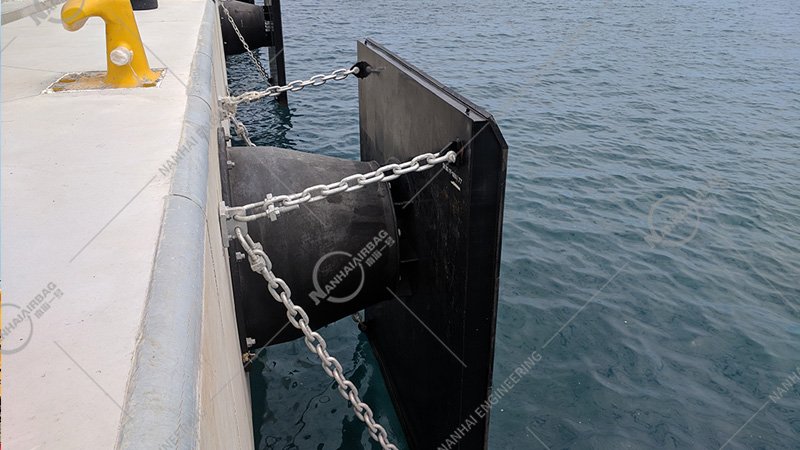Super Arch Rubber Fenders: The Marine Industry’s Secret Weapon for Collision Protection
19/06/2025Beenest Ship Launching Airbags: The Marine Industry’s Game-Changer for Safe, Stress-Free Launches
26/06/2025

If you’ve ever watched a massive cargo ship glide into a busy port, you’ve likely noticed the squishy, barrel-like structures lining the docks. Those are marine fenders—and not all are created equal. Enter super cone rubber fenders: the unsung heroes of modern port operations, designed to protect ships, docks, and cargo from the brute force of docking. Let’s dive in.
What Are Super Cone Rubber Fenders?
Super cone rubber fenders are cylindrical marine fenders engineered with a tapered, conical shape to maximize energy absorption while minimizing hull damage during ship-to-dock collisions. Unlike traditional cylindrical or square fenders, their unique design spreads impact forces evenly across the cone’s surface, reducing stress on both the ship and the fender itself. Made from high-quality rubber (often EPDM or neoprene), they’re built to withstand harsh marine environments—saltwater, UV rays, and extreme temperatures—without losing performance.
Why This Matters Now: The Urgency of Upgrading
Ports and shipping companies face a perfect storm of challenges that make super cone rubber fenders more critical than ever:
- Bigger Ships, Bigger Risks: Modern container ships can weigh over 24,000 TEUs (twenty-foot equivalent units)—that’s like parking 5,000 elephants on a floating platform. When these giants dock, the force of impact can crush older, rigid fenders, leading to costly repairs for both the ship and the port.
- Port Congestion: Delays cost money. A single collision can sideline a ship for days, disrupting supply chains and costing thousands per hour in lost time.
- Environmental Rules: Stricter regulations (like the IMO’s Ballast Water Management Convention) penalize oil spills or structural damage that harms marine life. Damaged hulls from poor fenders risk leaking fuel or cargo.
Take the Port of Rotterdam, for example: After upgrading to super cone fenders, they reported a 40% reduction in docking-related repairs and a 25% faster turnaround for vessels. The math is simple: better fenders mean safer, faster, cheaper operations.
Why Super Cone Fenders Stand Out (And Why You Should Care)
If you’re a port operator, ship manager, or logistics coordinator, here’s why these fenders deserve your attention:
- Superior Energy Absorption: The conical shape acts like a shock absorber, dissipating up to 30% more impact energy than traditional fenders. This means less wear and tear on ships (no more dented hulls!) and longer-lasting fenders.
- Versatility: They work with almost any vessel—from small ferries to massive LNG tankers. Whether docking at a busy container port or a remote oil terminal, super cones adapt to different speeds and angles.
- Cost Savings Over Time: While they may cost more upfront, their durability (10–15 year lifespan vs. 5–8 years for standard fenders) and reduced repair needs save money long-term. Plus, fewer collisions mean fewer delays—think of it as insurance against lost revenue.
People Also Ask: Your Top Questions About Super Cone Rubber Fenders
Q: How do super cone rubber fenders differ from regular marine fenders?
A: Traditional fenders (like cylindrical or rectangular ones) rely on rigid materials or simpler shapes, which can crack under pressure. Super cones use a tapered design to distribute force evenly, making them more resilient and effective at preventing damage.
Q: What sizes are available?
A: They range from small (1m–2m diameter) for small boats to massive (4m–6m) for cargo ships and tankers. Custom sizes are often available to fit specific dock or vessel needs.
Q: Are they easy to install?
A: Yes—most are bolt-on or boltless (using chains/anchors) and compatible with existing dock infrastructure. Many manufacturers also offer installation guides or on-site support.
Q: Do they work in cold climates?
A: Absolutely. High-quality super cone fenders are made with cold-resistant rubber (like EPDM), so they stay flexible even in subzero temperatures—no cracking or brittleness.
Final Thoughts: Don’t Let Docking Cost You
In an industry where every minute and dollar counts, super cone rubber fenders aren’t just an upgrade—they’re a necessity. They protect your assets, keep operations running smoothly, and future-proof your port against bigger ships and stricter rules.
Ready to see the difference? Start by researching trusted marine rubber fender manufacturers, or reach out to ports that have already made the switch. Your hull (and your bottom line) will thank you.
